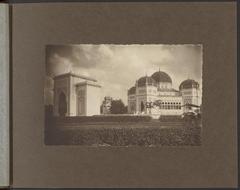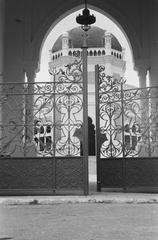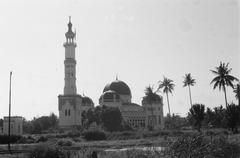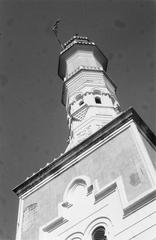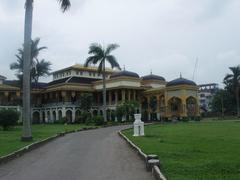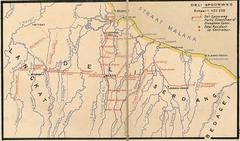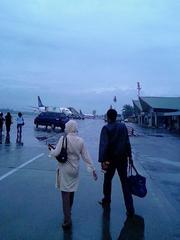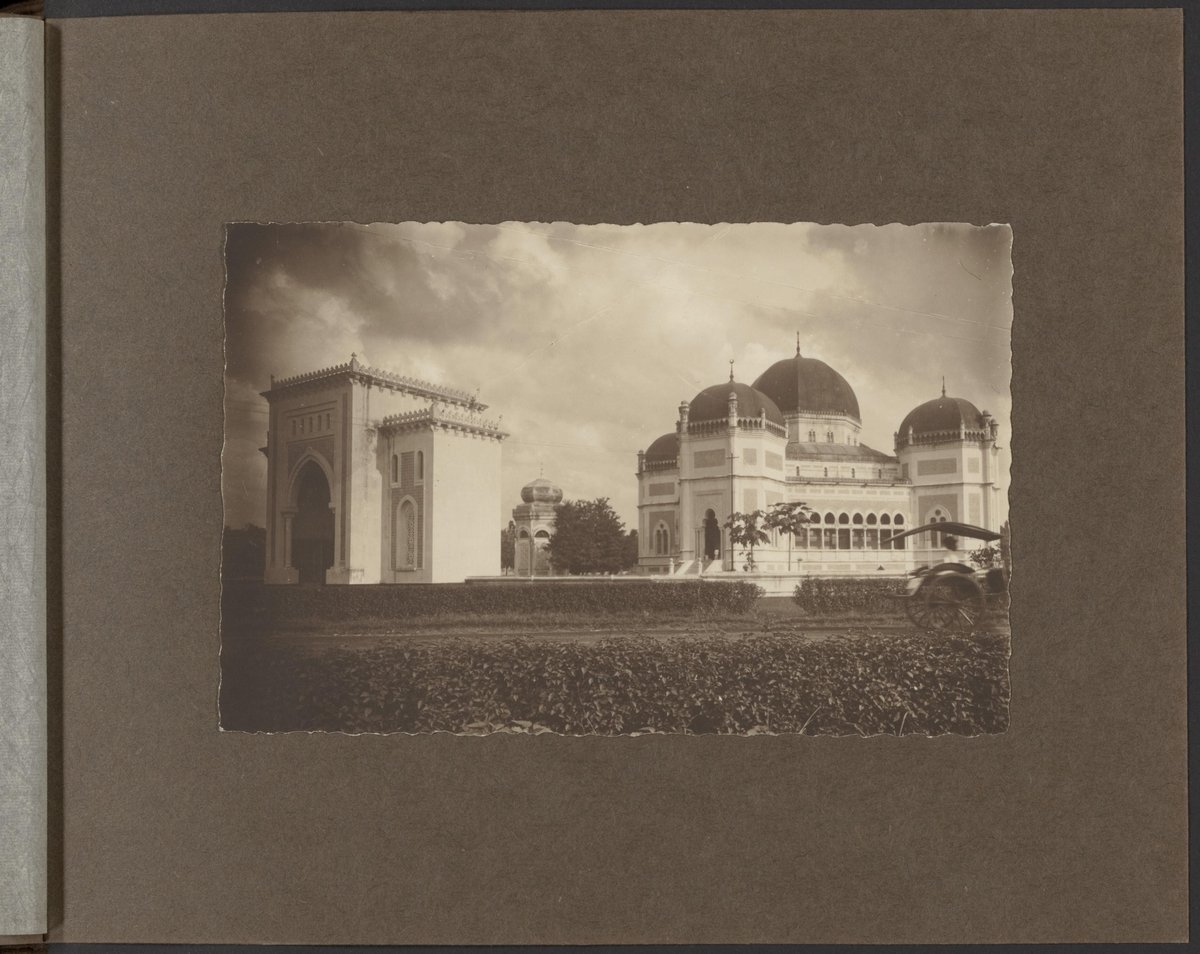
Great Mosque of Medan: Visiting Hours, Tickets, and Historical Significance
Date: 14/06/2025
Introduction
The Great Mosque of Medan, or Masjid Raya Al Mashun, is an architectural jewel and one of Indonesia’s most significant Islamic landmarks. Situated in the heart of Medan, North Sumatra, the mosque is both a vibrant center of worship and a living testament to the city’s multicultural heritage. Built between 1906 and 1909 under Sultan Ma’mun Al Rashid Perkasa Alam Shah IX, the mosque was conceived as a symbol of religious devotion, cultural integration, and political authority during the Deli Sultanate’s zenith. Its unique octagonal design, combining Middle Eastern, Indian, and Spanish-Moorish styles, along with imported materials like Italian marble and Chinese stained glass, reflects early 20th-century Medan’s cosmopolitan vision (salsawisata.com; medium.com; en.wikipedia.org).
Today, the mosque continues to serve as North Sumatra’s primary place of worship, hosting thousands of worshippers daily and during Islamic festivals. It also stands as a beacon of religious tolerance and multiculturalism, attracting visitors interested in history, architecture, and cultural life (Agoda Travel Guide; TripSavvy). This guide provides comprehensive information on the mosque’s history, architecture, visiting hours, ticketing, etiquette, and travel tips, as well as recommended nearby attractions to ensure a respectful and enriching visit.
Table of Contents
- Introduction
- Historical Background and Architectural Design
- Architectural Features
- Visitor Information
- Nearby Attractions and Suggested Itineraries
- FAQs
- Conclusion
- References
Historical Background and Architectural Design
Origins and Patronage
The Great Mosque’s construction began in 1906 and was completed in 1909, commissioned by Sultan Ma’mun Al Rashid Perkasa Alam Shah IX, ruler of the Deli Sultanate. The Sultan intended for the mosque to surpass even his own royal residence, the Maimun Palace, in grandeur, cementing its status as a symbol of Islamic faith and royal power (salsawisata.com; rentalcarmedan.com).
Historical Context and Community Involvement
The mosque’s construction coincided with the Deli Sultanate’s peak and Dutch colonial rule. Financing came from the Sultan as well as Tjong A Fie, a prominent Chinese merchant, reflecting Medan’s multicultural society (medium.com). Originally, the mosque was part of the royal complex, situated near Maimun Palace, emphasizing its role as both a religious and social hub (salsawisata.com).
Evolution as a Landmark
Throughout colonial and post-independence periods, the mosque has endured as a symbol of Islamic resilience and local identity. Today, it is recognized as a major tourist and religious site, drawing local and international visitors for its history, architecture, and communal activities (travelsetu.com).
Architectural Features
Style and Influences
The mosque showcases a blend of Middle Eastern, Indian, and Spanish-Moorish architectural styles, symbolizing Medan’s cosmopolitan character (en.wikipedia.org; sumut.idntimes.com). Its octagonal floor plan is rare in Indonesian mosques. The initial design was by Dutch architect Theodoor van Erp, later completed by JA Tingdeman (medium.com).
Structural Elements and Materials
The mosque’s main prayer hall is supported by eight robust columns, with a central dome and four smaller domes on its wings. Two minarets rise at the rear. Notably, materials were imported: marble from Italy and Germany, stained glass from China, and chandeliers from France (medium.com), creating a lavish and internationally influenced interior.
Interior and Decorative Highlights
Inside, the mosque dazzles with Islamic calligraphy, arabesque motifs, and geometric patterns. The stained glass windows create a kaleidoscopic effect in the prayer hall, while the mihrab and minbar are ornately decorated (thetouristchecklist.com). The mosque’s exterior features grand domes and Moroccan-style minarets, surrounded by peaceful gardens.
Capacity and Layout
Set on an 18,000-square-meter site, the mosque can accommodate up to 2,000 worshippers, with expanded capacity during major religious events. The open courtyards and gardens foster a welcoming atmosphere (rentalcarmedan.com).
Location and Accessibility
Located on Jalan Sisingamangaraja No. 61, the mosque is within walking distance of Maimun Palace and central Medan (salsawisata.com), making it easy to include on any heritage tour.
Visitor Information
Visiting Hours
- Open: Daily, 8:00 AM to 5:00 PM
- Note: Non-Muslim visitors should avoid visiting during prayer times, especially Friday noon prayers, to respect worshippers (Langyaw).
Ticket Policy
- Entry: Free for all visitors
- Donations: Welcomed to support upkeep and community programs (JS Travel Diaries)
Dress Code and Etiquette
- Dress Modestly: Men should wear long pants and sleeved shirts. Women must cover hair, arms, and legs; robes and scarves are available at the entrance (JS Travel Diaries).
- Shoes: Remove before entering the prayer hall.
- Behavior: Maintain quiet; avoid disruptive behavior and walking in front of people praying. Photography is allowed, but always ask permission and avoid flash, especially during prayers (TripSavvy).
Accessibility and Facilities
- Wheelchair Access: Ramps at main entrances; accessible restrooms available.
- Restrooms and Ablution: Separate, clean facilities for men and women.
- Courtyards and Gardens: Shaded spaces for rest and contemplation.
Guided Tours
- Guides: English-speaking guides are often available at the entrance; advance booking is possible via WhatsApp (JS Travel Diaries).
- Self-Guided: Limited informational signage; guides are recommended for deeper understanding.
Travel Tips
- Visit early in the morning or late afternoon for optimal lighting and fewer crowds.
- Carry a water bottle and dress for Medan’s hot, humid climate.
- Wear shoes that are easy to remove.
Nearby Attractions and Suggested Itineraries
Notable Nearby Sites
- Maimun Palace: A seven-minute walk, this royal palace showcases Malay, Islamic, and European styles and offers exhibits on Deli sultans (Agoda).
- Tjong A Fie Mansion: A 22-minute walk, this mansion blends Chinese, Malay, and European elements, telling the story of Medan’s Chinese community (Adventure Backpack).
- North Sumatra Museum: About 21 minutes on foot, this museum displays local ethnography, artifacts, and history.
- Sri Mariamman Temple: Medan’s oldest Hindu temple, 33 minutes on foot, famed for its colorful architecture.
- Sumatran Numismatic Museum: 15 minutes away, focused on Indonesia’s currency history.
- Tirtanadi Water Tower: 14 minutes’ walk, a colonial-era landmark and popular photo spot.
- Kesawan District: Medan’s oldest street, about 38 minutes’ walk, lined with colonial buildings and cafes.
Suggested Itineraries
Half-Day Heritage Walk
- Great Mosque of Medan → Maimun Palace → Tjong A Fie Mansion → Kesawan District or Sumatran Numismatic Museum (Adventure Backpack)
Full-Day Cultural Immersion
- Morning: Mosque & Maimun Palace
- Midday: North Sumatra Museum & lunch at Centre Point
- Afternoon: Tjong A Fie Mansion, Sumatran Numismatic Museum, Tirtanadi Water Tower
- Evening: Sri Mariamman Temple, Kesawan District, dinner at Merdeka Walk (Holidify)
Frequently Asked Questions (FAQ)
Q: What are the Great Mosque of Medan’s visiting hours?
A: Open daily from 8:00 AM to 5:00 PM; avoid prayer times.
Q: Is there an entrance fee?
A: No, entry is free for all visitors.
Q: Are guided tours available?
A: Yes, English-speaking guides are often available and can be arranged in advance.
Q: Is the mosque accessible for people with disabilities?
A: The mosque has ramps and accessible restrooms, though some areas may have steps.
Q: Can I take photographs inside?
A: Yes, but avoid flash and always ask permission, especially during prayers.
Q: What is the dress code?
A: Modest clothing is required. Men: long pants and sleeves; women: cover hair, arms, and legs. Robes/hijabs are available if needed.
Conclusion
The Great Mosque of Medan is not only a center of worship but also a vibrant emblem of North Sumatra’s rich cultural and religious heritage. Its architectural splendor, open-door policy, and proximity to other historical sites make it an essential stop for any visitor to Medan. By observing respectful dress and etiquette and exploring the surrounding area, visitors can enjoy a profound and memorable cultural experience. For updates on visiting hours and local events, check official sources and consider using the Audiala app for personalized tips and navigation.
References
- Masjid Raya Al Mashun (The Great Mosque of Medan) Overview, 2024, Salsawisata
- The History of the Construction of the Grand Mosque in Medan, 2023, Medium
- Grand Mosque of Medan, 2024, Wikipedia
- Discover the Charms of Medan: A Comprehensive 5-Day Itinerary, 2024, Agoda Travel Guide
- Mosque Etiquette for Visitors, 2024, TripSavvy
- Great Mosque of Medan, 2024, Indonesia Tourism
- Discovering the Grand Mosque Medan, 2024, Langyaw
- Things to Do in Medan, 2024, JS Travel Diaries
- Masjid Raya Al-Mashun The Great Mosque of Medan, 2024, Asia Tours
- Medan Tourism and Places to Visit, 2024, TravelSetu
- Ultimate Travel Tips for Medan, 2024, STR Specialist
- Medan Sightseeing and Things to Do, 2024, Holidify
- Trek Zone - Great Mosque of Medan, 2024
